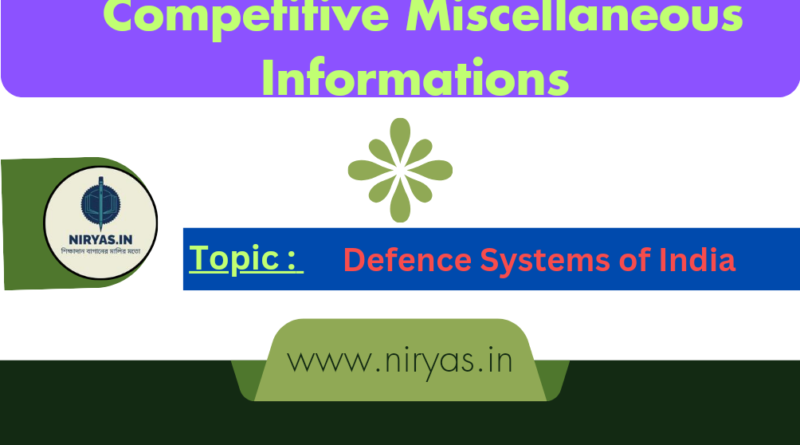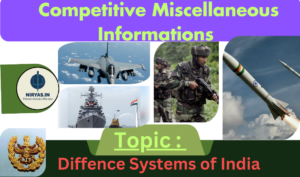Defense Systems of India
Defense Systems of India
Welcome to www.niryas.in. In the field of competitive exams, brief information on various subjects helps the competing students. Although there are numerous contents in this case, a proper idea about to-the-point information on several subjects keeps the competing students ahead. Based on some such contents, we have presented the Competitive Information Niryas sub-section of the Competitive Exam Preparation section. In this sub-section, in the post called Defense Systems of India, we will now discuss some brief information related to Indian Defense Systems. So let’s take a look at the information.
Defense Systems of India
India’s Defense Systems : A Comprehensive Overview : India, a rapidly growing economic power, has a complex and multifaceted defense system that plays a vital role in protecting the country’s sovereignty and territorial integrity. The defense system of India is a robust and well-structured framework that comprises various branches, agencies, and organizations. This essay provides an overview of India’s defense systems, highlighting their key features, strengths, and weaknesses.
➤ At the heart of India’s defense system are the three branches of the Indian Armed Forces: the Indian Army, Indian Navy, and Indian Air Force. The Indian Army is responsible for land-based military operations, while the Indian Navy and Indian Air Force are responsible for naval and air-based operations, respectively. Each branch of the armed forces has its own distinct structure, with a clear chain of command and a well-defined doctrine.
➤ In addition to the three branches of the armed forces, India’s defense system also includes various paramilitary forces, such as the Assam Rifles, Border Security Force, and Central Reserve Police Force. These forces play a vital role in maintaining law and order in troubled areas, guarding the country’s borders, and providing security to critical infrastructure and industrial establishments.
➤ India’s defense system also includes various defense intelligence agencies, such as the Defence Intelligence Agency, National Technical Research Organisation, and Directorate of Naval Intelligence. These agencies are responsible for collecting and analyzing strategic military intelligence, technical intelligence gathering, and naval intelligence gathering.
➤ The Defence Research and Development Organisation (DRDO) is another critical component of India’s defense system. The DRDO is responsible for developing indigenous defense technologies, including missiles, aircraft, and naval systems. The organisation has made significant contributions to India’s defense capabilities, including the development of the Agni and Prithvi missiles.
➤ India’s defense system also includes various other organisations, such as the National Defence College, Defence Planning Staff, and Integrated Defence Staff. These organisations play a vital role in training senior defense officers, defense planning and strategy, and coordinating defense operations and planning.
➲ Defense Systems of India : India has a well-structured defense system, which includes:
1. Three Branches of Defense
i. Indian Army : Responsible for land-based military operations.
ii. Indian Navy : Responsible for naval operations and protecting India’s maritime interests.
iii. Indian Air Force : Responsible for air-based military operations.
2. Defense Intelligence Agencies
i. Defence Intelligence Agency (DIA) : Responsible for collecting and analyzing strategic military intelligence.
ii. National Technical Research Organisation (NTRO) : Responsible for technical intelligence gathering.
iii. Directorate of Naval Intelligence (DNI) : Responsible for naval intelligence gathering.
3. Paramilitary Forces
i. Assam Rifles (AR) : A border security force responsible for guarding India’s northeastern borders.
ii. Border Security Force (BSF) : Responsible for guarding India’s international borders.
iii. Central Industrial Security Force (CISF) : Responsible for providing security to critical infrastructure and industrial establishments.
iv . Central Reserve Police Force (CRPF) : A counter-insurgency force responsible for maintaining law and order in troubled areas.
v. Indo-Tibetan Border Police (ITBP) : Responsible for guarding India’s borders with China.
vi. National Security Guard (NSG) : An elite counter-terrorism force.
vii. Sashastra Seema Bal (SSB) : Responsible for guarding India’s borders with Nepal and Bhutan.
4. Defense Research and Development
i. Defence Research and Development Organisation (DRDO) : Responsible for developing indigenous defense technologies.
ii. Defence Research Laboratory (DRL) : A research laboratory focused on developing advanced defense technologies.
5. Other Defense Organizations
i. National Defence College (NDC) : A premier defense institute responsible for training senior defense officers.
ii. Defence Planning Staff (DPS) : Responsible for defense planning and strategy.
iii. Integrated Defence Staff (IDS) : Responsible for coordinating defense operations and planning.
Defense Systems of India
➲ 1. Three Branches of Defense :
➮ Indian Army
❖ Formation Date : April 1, 1895 (as the British Indian Army), August 15, 1947 (as the Indian Army)
❖ Chief : General Manoj Pande, PVSM, AVSM, VSM, ADC (Chief of the Army Staff)
❖ Headquarters : Integrated Headquarters of the Ministry of Defence (Army), New Delhi
❖ Motto : “Service Before Self”
❖ Responsibilities : Land-based military operations, defending the nation’s borders, and maintaining internal security
❖ Commands :
⦿ Northern Command : Based in Udhampur, Jammu and Kashmir, focusing on the borders with Pakistan and China.
⦿ Western Command : Headquartered in Chandimandir, Haryana, guarding the Western front with Pakistan.
⦿ Eastern Command : Located in Kolkata, securing the Eastern borders with China and Myanmar.
⦿ Southern Command : Based in Pune, Maharashtra, maintaining internal security and operations in the southern states.
⦿ Central Command : Headquartered in Lucknow, Uttar Pradesh, acting as a reserve force for Northern and Western fronts.
⦿ South Western Command : Located in Jaipur, Rajasthan, operating along the Rajasthan-Punjab axis.
⦿ Army Training Command (ARTRAC) : Based in Shimla, Himachal Pradesh, responsible for training and doctrine development.
➮ Indian Navy
❖ Formation Date : September 5, 1612 (as the British East India Company’s Marine), April 1, 1950 (as the Indian Navy)
❖ Chief : Admiral R. Hari Kumar, PVSM, AVSM, VSM, ADC (Chief of the Naval Staff)
❖ Headquarters : Integrated Headquarters of the Ministry of Defence (Navy), New Delhi
❖ Motto : “Sham No Varunah” (“May the Lord of the Oceans be auspicious unto us”)
❖ Responsibilities : Naval operations, protecting India’s maritime interests, and safeguarding the nation’s coastline
❖ Commands :
⦿ Western Naval Command : Based in Mumbai, Maharashtra, overseeing operations in the Arabian Sea.
⦿ Eastern Naval Command : Headquartered in Visakhapatnam, Andhra Pradesh, responsible for the Bay of Bengal.
⦿ Southern Naval Command : Training command located in Kochi, Kerala.
Defense Systems of India
➮ Indian Air Force
❖ Formation Date : October 8, 1932
❖ Chief : Air Chief Marshal Vivek Ram Chaudhari, PVSM, AVSM, VM, ADC (Chief of the Air Staff)
❖ Headquarters : Vayu Bhavan, New Delhi
❖ Motto : “Touch the Sky with Glory”
❖ Responsibilities : Air-based military operations, defending the nation’s airspace, and providing airlift capabilities for military and humanitarian missions
❖ Commands :
⦿ Western Air Command : Based in New Delhi, overseeing operations in the Western sector.
⦿ Eastern Air Command : Headquartered in Shillong, Meghalaya, responsible for the Eastern sector.
⦿ Central Air Command : Located in Prayagraj (Allahabad), Uttar Pradesh, providing logistic support and reinforcements.
⦿ Southern Air Command : Based in Thiruvananthapuram, Kerala, securing the Southern peninsula and maritime airspaces.
⦿ South Western Air Command : Headquartered in Gandhinagar, Gujarat, covering the nation’s Western desert
➲ Chief of Defence Staff (CDS) in India’s defense systems:
❖ Establishment and Tenure
⦿ Established : January 1, 2020
⦿ First CDS : General Bipin Rawat
⦿ 2nd & Present CDS : General Anil Chauhan (From September 30, 2022)
⦿ Tenure : 3 years or up to the age of 65
❖ Responsibilities and Functions
⦿ Integration and Coordination : Integrates and coordinates the three branches of the Indian Armed Forces
⦿ Strategic Planning : Responsible for strategic planning, including the development of military doctrine
⦿ Joint Operations : Oversees joint operations, ensuring that the three services operate in a coordinated and effective manner
⦿ Defense Acquisition : Plays a key role in defense acquisition, ensuring that the military’s modernization needs are met
❖ Organizational Structure
⦿ Department of Military Affairs (DMA) : The CDS is the head of the DMA, which is responsible for promoting jointness and integration among the three services
⦿ Integrated Defence Staff (IDS) : The CDS is also the head of the IDS, which is responsible for coordinating defense operations and planning
Defense Systems of India
➲ 2. Defense Intelligence Agencies :
➮ Defence Intelligence Agency (DIA)
❖ Formation Date : March 2002
❖ Chief : Lieutenant General G. A. V. Reddy, PVSM, AVSM, VSM (Director General, DIA)
❖ Headquarters : Ministry of Defence, New Delhi
❖ Motto : “Sachetak” (“Vigilance”)
❖ Responsibilities : Collecting and analyzing strategic military intelligence
❖ Branches :
⦿ Directorate of Signals Intelligence_: A tri-service agency responsible for acquiring and decrypting enemy communications.
⦿ Defence Image Processing and Analysis Centre (DIPAC)_: Controls India’s satellite-based image acquisition capabilities.
⦿ Defence Information Warfare Agency (DIWA)_: Handles all elements of the information warfare repertoire.
Defense Systems of India
➮ National Technical Research Organisation (NTRO)
❖ Formation Date : 2004
❖ Chief : Mr. Anil Dhasmana, IPS (Chairman, NTRO)
❖ Headquarters : National Security Council Secretariat, New Delhi
❖ Motto : “Science for National Security”
❖ Responsibilities : Technical intelligence gathering
❖ Branches :
⦿ National Critical Information Infrastructure Protection Centre (NCIIPC)_: Protects critical information infrastructure.
⦿ National Institute of Cryptology Research and Development (NICRD)_: Focuses on cryptologic education and research.
➮ Directorate of Naval Intelligence (DNI)
❖ Formation Date : 1950
❖ Chief : Rear Admiral K. M. Naveen Kumar, NM (Assistant Chief of Naval Staff, Intelligence)
❖ Headquarters : Integrated Headquarters, Ministry of Defence (Navy), New Delhi
❖ Motto : “Satyam Param Dharma” (“Truth is the highest virtue”)
❖ Responsibilities : Naval intelligence gathering
❖ Branches :
⦿ Naval Intelligence Division_: Collects and analyzes naval intelligence.
⦿ Directorate of Naval Operations_: Oversees naval operations and plans.
⦿ Directorate of Naval Intelligence (Operations)_: Focuses on naval intelligence operations.
➲ 3. Paramilitary Forces :
➮ Assam Rifles (AR)
❖ Formation Date : March 24, 1835
❖ Chief : Lieutenant General P. C. Nair, AVSM, YSM (Director General, AR)
❖ Headquarters : Shillong, Meghalaya
❖ Motto : “Friends of the Hill People”
❖ Responsibilities : Border security force responsible for guarding India’s northeastern borders
➣ বাংলায় পড়ুন : National Identity Elements India
➮ Border Security Force (BSF)
❖ Formation Date : December 1, 1965
❖ Chief : Shri Deepak Kumar, IPS (Director General, BSF)
❖ Headquarters : New Delhi
❖ Motto : “Jeevan Paryant Kartavya” (“Duty Unto Death”)
❖ Responsibilities : Responsible for guarding India’s international borders
➮ Central Industrial Security Force (CISF)
❖ Formation Date : June 10, 1969
❖ Chief : Shri Rajesh Kumar, IPS (Director General, CISF)
❖ Headquarters : New Delhi
❖ Motto : “Protection and Security”
❖ Responsibilities : Responsible for providing security to critical infrastructure and industrial establishments
➮ Central Reserve Police Force (CRPF)
❖ Formation Date : July 27, 1939
❖ Chief : Shri Anand Prakash Maheshwari, IPS (Director General, CRPF)
❖ Headquarters : New Delhi
❖ Motto : “Service and Loyalty”
❖ Responsibilities : A counter-insurgency force responsible for maintaining law and order in troubled areas
➮ Indo-Tibetan Border Police (ITBP)
❖ Formation Date : October 24, 1962
❖ Chief : Shri Anish Dayal Singh, IPS (Director General, ITBP)
❖ Headquarters : New Delhi
❖ Motto : “Shaurya, Dridhata, Karm Nishtha” (“Valour, Steadfastness, and Devotion to Duty”)
❖ Responsibilities : Responsible for guarding India’s borders with China
➮ National Security Guard (NSG)
❖ Formation Date : October 16, 1984
❖ Chief : Major General M. K. Das, SM, VSM (Director General, NSG)
❖ Headquarters : New Delhi
❖ Motto : “Sarvatra Sarvottam Suraksha” (“Universal Best Security Everywhere”)
❖ Responsibilities : An elite counter-terrorism force
➮ Sashastra Seema Bal (SSB)
❖ Formation Date : December 20, 1963
❖ Chief : Shri Satya Narayan Pradhan, IPS (Director General, SSB)
❖ Headquarters : New Delhi
❖ Motto : “Seva, Suraksha, Satarkta” (“Service, Security, Vigilance”)
❖ Responsibilities : Responsible for guarding India’s borders with Nepal and Bhutan
Defense Systems of India
➲ 4. Defense Research and Development :
➮ Defence Research and Development Organisation (DRDO)
❖ Formation Date : May 1958
❖ Chief : Dr. Samir V. Kamat (Chairman, DRDO)
❖ Headquarters : New Delhi
❖ Motto : “Balasya Mulam Vigyanam” (“The Strength of a Nation is in Science”)
❖ Responsibilities : Responsible for developing indigenous defense technologies
❖ Laboratories : 52 laboratories across India, including:
⦿ Aeronautical Development Agency (ADA)
⦿ Defence Avionics Research Establishment (DARE)
⦿ Defence Bioengineering and Electro Medical Laboratory (DEBEL)
⦿ Defence Electronics Research Laboratory (DLRL)
⦿ Defence Materials and Stores Research and Development Establishment (DMSRDE)
⦿ Defence Metallurgical Research Laboratory (DMRL)
⦿ Defence Research and Development Laboratory (DRDL)
⦿ Defence Research Laboratory (DRL)
⦿ Institute of Nuclear Medicine and Allied Sciences (INMAS)
⦿ Integrated Test Range (ITR)
⦿ Jagadish Chandra Bose National Centre for Advanced Scientific Research
⦿ Microwave Tube Research and Development Centre (MTRDC)
⦿ Naval Chemical and Biological Defence Laboratory (NCBDL)
⦿ Naval Materials Research Laboratory (NMRL)
⦿ Naval Physical and Oceanographic Laboratory (NPOL)
⦿ Naval Research Laboratory (NRL)
⦿ Proof and Experimental Establishment (PXE)
⦿ Scientific Analysis Group (SAG)
⦿ Snow and Avalanche Study Establishment (SASE)
⦿ Solid State Physics Laboratory (SSPL)
Defense Systems of India
➮ Defence Research Laboratory (DRL)
❖ Formation Date : 1958
❖ Chief : Dr. K. K. Mishra (Director, DRL)
❖ Headquarters : Tezpur, Assam
❖ Motto : “S&T for Defence and Beyond”
❖ Responsibilities : A research laboratory focused on developing advanced defense technologies
❖ Research Areas : Focuses on research in areas like:
⦿ Biotechnology
⦿ Biomedical Engineering
⦿ Computational Modelling and Simulation
⦿ Cyber Security
⦿ Electronics and Communication Engineering
⦿ Materials Science and Engineering
⦿ Mechanical Engineering
⦿ Nanotechnology
⦿ Networking and Distributed Systems
⦿ Optoelectronics and Laser Technology
⦿ Robotics and Automation
⦿ Signal Processing and Communication
➲ 5. Other Defense Organizations :
➮ National Defence College (NDC)
❖ Formation Date : April 27, 1960
❖ Chief : Air Marshal Diptendu Choudhury, AVSM, VM, VSM (Commandant, NDC)
❖ Location : New Delhi, India
❖ Motto : “Buddhiryasya Balamtasya” (“He who has wisdom has the strength”)
❖ Responsibilities : Premier defense institute responsible for training senior defense officers
❖ Course : Offers a 47-week National Security and Strategic Study course
➮ Defence Planning Staff (DPS)
❖ Formation Date : 1985
❖ Chief : Vice Admiral Atul Kumar Jain, PVSM, AVSM, VSM (Deputy Chief of Integrated Defence Staff for Policy Planning and Force Development)
❖ Headquarters : Integrated Defence Headquarters, New Delhi
❖ Responsibilities : Responsible for defense planning and strategy
❖ Role : Provides inputs for defense planning and strategy formulation
➮ Integrated Defence Staff (IDS)
❖ Formation Date : 2001
❖ Chief : Vice Admiral Atul Kumar Jain, PVSM, AVSM, VSM (Deputy Chief of Integrated Defence Staff)
❖ Headquarters : Integrated Defence Headquarters, New Delhi
❖ Responsibilities : Responsible for coordinating defense operations and planning
❖ Role : Ensures jointness among the three services and facilitates integrated planning and operations
Defense Systems of India
➤ In conclusion, India’s defense systems are complex and multifaceted, comprising various branches, agencies, and organisations. The defense system plays a vital role in protecting India’s sovereignty and territorial integrity, and has made significant contributions to the country’s defense capabilities. However, the defense system also faces various challenges, including the need to modernise and indigenise defense technologies, improve defense infrastructure, and enhance defense cooperation with other countries.




